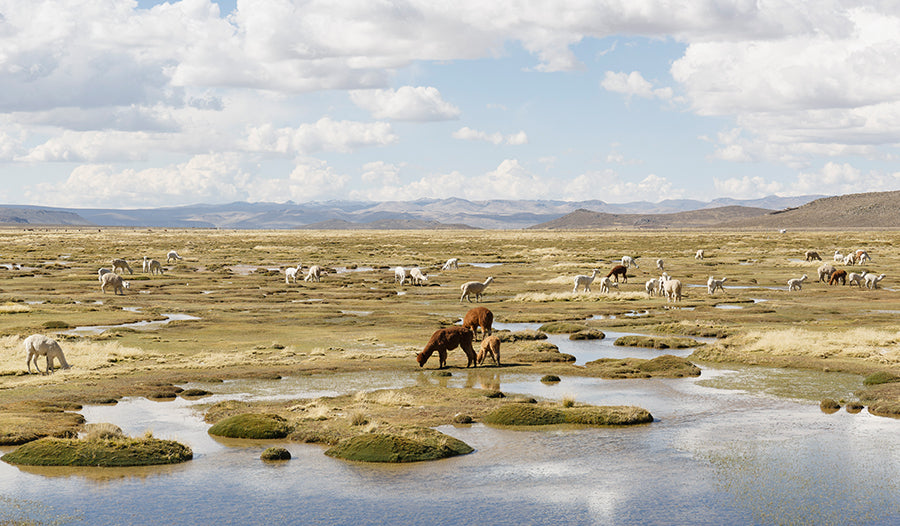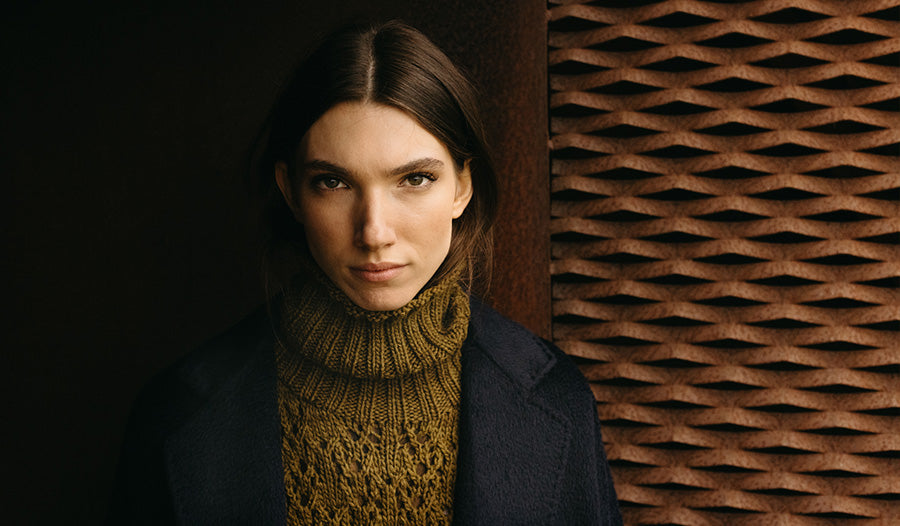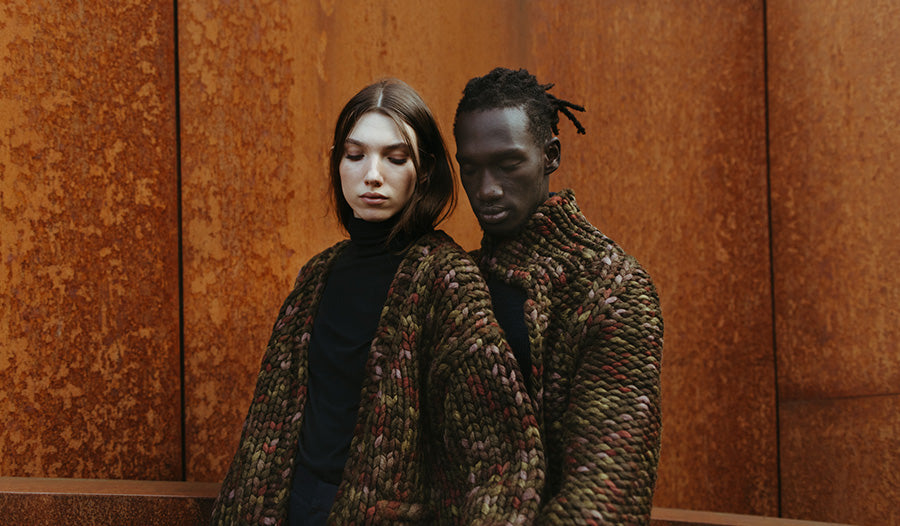
KNITBRARY: KNIT TWO TOGETHER

Could you name the four different camelids found in South America?
Many brands have been seduced by Peru’s fibres and manufacture their knitwear there. However, the Spanish brand Knitbrary chose to do things differently, opening an atelier in Arequipa with the purpose of working locally with the precious camelid fibres.

In South America, there are four camelids: llamas, alpacas, guanacos and vicuñas. These two-toed herbivores are related to the old world camel species, Arabian and Bactrian camels. However, these camelids lack the one-hump/two-hump characteristics and are much smaller. The smallest and rarest is the vicuña, whose luxurious wool is considered to be the finest animal fibre in the world. In fact, textiles made from vicuña fibre were reserved for Inca royalty. Today in Peru, vicuñas wool is harvested in an annual ceremony called Chaku, during which the locals form a human chain and herd the vicuñas into a corral where they can be examined and selected for shearing. Due to its short fibre, each vicuña is shorn every three years. One kilo of freshly-shorn wool can fetch $500. Because of the coveted nature of vicuña fleece, this animal was nearly hunted to extinction in the 1960s. However, as a result of conservation programmes, especially in the reserves of Pampa Galeras and Salinas y Aguada, the vicuña is making a comeback in Peru and throughout South America.

The alpaca is native to the Peruvian highlands and is the second domesticated South American camelid. Its natural habitat can reach an altitude of 4,500 metres above sea level, where weather conditions are harsh and change rapidly. The alpaca’s fleece, which is soft, light, waterproof and resistant to solar radiation, has allowed the animal to adapt to its extreme environment. There are two breeds of alpaca: the huacaya which has dense, curly wool; and the suri which has long, wavy wool. While the alpaca is best known for its fleecy wool, it is also important to note that in Peru, alpacas are often raised for their meat. In fact, alpaca meat is very tasty and has almost no cholesterol, making it a delicacy in the Cusco region of Peru.
Peru holds over 80% of the global alpaca population with Arequipa sitting at the centre of the alpaca industry. This colonial city benefits from a variety of advantages, ranging from a high concentration of alpacas, to the presence of a key set of regional manufacturing companies, to an abundance of talented artisans who are versed in the handling of these precious fibres.

Following their fascination with Peruvian fibres, Pedro Castellanos and Yolanda Estevez chose Arequipa as their second home and the place to develop their collections that now have a cult following–especially amongst Japanese connoisseurs. Founded ten years ago, the couple defines their brand as a continuation of the way they approach life; both are lovers of details and are proud to be involved in every step of the process: design, colour, embellishment, and finishes.
Yolanda and Pedro met 25 years ago and reunited when both were living in A Coruña. Yolanda comes from the world of textile design and worked for big companies in Spain. ‘After working for the industry and being focused on quantity, I needed to regain my love of craftsmanship, artisanal processes.’

‘We founded Knitbrary to create a “knit library” in which to offer the best quality in the world, always 100% natural and knit in their place of origin with local artisans. When deciding where to start, we chose Peru, because we were already familiar with its extraordinary quality and variety of wonderful fibres (Baby Alpaca, Pima Cotton, Vicuña) and thus the concept "archive" would make sense from the beginning. Our relationship with Peru has grown stronger over time. We have our own workshop in Arequipa–our second home–where we live almost six months out of the year,’ affirms Pedro.

Of all the fibres they work with, vicuña is the rarest. ‘Working with Vicuña is a real luxury. Vicuñas are wild animals and highly protected by Peruvian institutions. It is the finest yarn in the world and has an exceptional touch. We could not say that we work with the best Peruvian qualities and not have Vicuña in our archive. It is such a rare and precious yarn that the samples are developed with another fibre that has a similar behavior; until that prototype is perfect, it is not knit in vicuña. When we show our pieces, we always save the vicuña for last. They are heirloom pieces to treasure.’
As all good things, Knitbrary has not been easy or fast. However, Pedro and Yolanda have remained faithful to the original mission without shortcuts or compromises. ‘We believe in a “silent luxury” that can be perceived beyond the senses, one that is linked with intangible aspects such as time, craftsmanship, emotion, and respect, and that is not always understood.’

Knitbrary has a personal colour palette: ‘We are alchemists as we create our own colours and name them in each collection; it is one of the moments we enjoy the most.’ One of the first stages in their creative process starts with words that give way to textures, then yarns, and finally colours. ‘We use natural organic dyes. To maintain a certain homogeneity and fixation in the colours, we work with pigments acquired from specialised companies, although sometimes we develop our own inputs from plants and minerals.’

Knitbrary’s dyeing process is done by hand. To minimize water consumption, they avoid submerging the yarns in dye and rather apply the dyes directly on the skeins. ‘We never achieve flat colours; accents always appear, unexpected imperfections that with hand knitting make each piece unique and unrepeatable. In fact, the way we work with colour is one of the aspects that most defines us,’ says Pedro. When it comes to spinning the yarn, the process is even more thorough, as different colours are applied directly to the skein, covering small sections and creating a pattern. ‘Until we knit, we don't know if these colours work or not. The same technique can work in one stitch pattern and not in another, and if it does not work, we have to start over.’
Castellanos’ and Estevez’s dream is ‘to explore other artisanal processes and replicate this experience in other parts of the world.’
Excerpt from the article Double Knit: Knitbrary, Knit Two Together, written by Marcella Echavarría in Issue 104 Keeping Warm.
--
Find out more about Knitbrary on Instagram @Knitbrary or on their website: www.knitbrary.com
All images courtesy Knitbrary.
